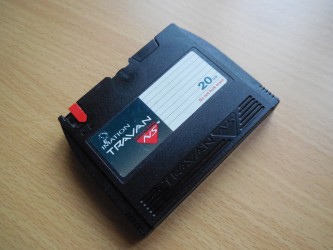Cart 6 Product Products 1 780,00 Kč (empty)
-
 1 x MIDI...650,00 Kč
1 x MIDI...650,00 Kč -
 1 x AMD P8088-1220,00 Kč
1 x AMD P8088-1220,00 Kč -
 1 x Macronix...210,00 Kč
1 x Macronix...210,00 Kč -
 1 x Originální...450,00 Kč
1 x Originální...450,00 Kč -
 1 x Commodore...150,00 Kč
1 x Commodore...150,00 Kč -
 1 x Přepínač...100,00 Kč
1 x Přepínač...100,00 Kč
No products
To be determined Shipping
1 780,00 Kč Total
Product successfully added to your shopping cart
Quantity
Total
There are 6 items in your cart. There is 1 item in your cart.
Total products 1 780,00 Kč
Total shipping To be determined
Total 1 780,00 Kč
Please wait...!
Imation Travan 20GB
TRAVAN20
Used
The Travan 20GB is a magnetic tape cartridge designed for data backup, belonging to the Travan tape storage family. This format was popular in the 1990s and early 2000s, before being replaced by more modern storage solutions like external HDDs, SSDs, and cloud storage.
1 Item
More info
The Travan 20GB is a magnetic tape cartridge designed for data backup, belonging to the Travan tape storage family. This format was popular in the 1990s and early 2000s, before being replaced by more modern storage solutions like external HDDs, SSDs, and cloud storage.
Main Features:
- Media Type: Magnetic tape
- Capacity:
- 10GB uncompressed
- 20GB compressed (with a 2:1 compression ratio, depending on the drive and data type)
- Format: Travan (TR-5)
- Size: Similar to QIC (Quarter-Inch Cartridge) tapes, but with higher capacity
- Usage: Backup storage for personal computers and small servers
- Compatibility: Required a Travan tape drive (typically using IDE, SCSI, or USB interface)
- Manufacturers: 3M (later Imation), HP, Seagate, IBM
History & Significance:
- Travan was developed as a more affordable alternative to professional backup systems (such as DAT and DLT).
- It had higher capacity than standard QIC tapes and was mainly targeted at home and office users.
- Its downsides included slower transfer speeds and limited tape lifespan with frequent use.
Current Status:
- This technology is now obsolete and has been replaced by modern backup methods.
- Travan 20GB tapes can sometimes be found on eBay or other second-hand markets, but their practical use today is very limited.
- They are mostly of interest as collector’s items or for retrieving data from old archives.
Reviews
No customer reviews for the moment.






